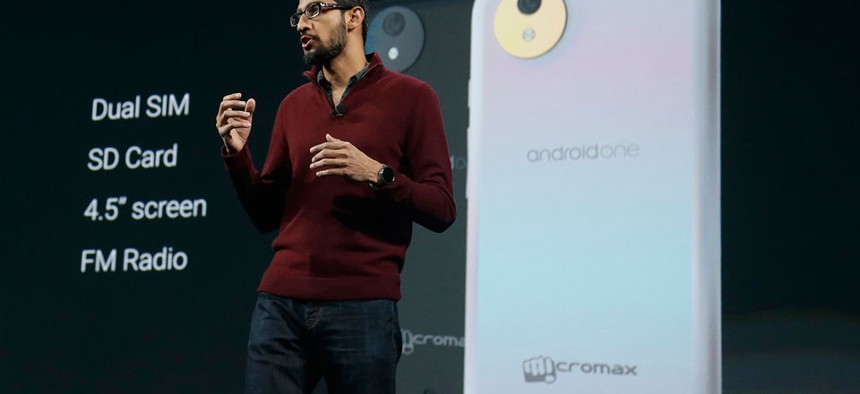Google’s Latest Empire-Building Tactic: Cheap Phones

Sundar Pichai, senior vice president of Android, Chrome and Apps, speaks about the Android One phone during the Google I/O 2014 keynote presentation in San Francisco. Jeff Chiu/AP
The company announced its AndroidOne initiative that will allow makers of cheap smartphones produce them more quickly.
Here’s the thing about those cheap sub-$100 smartphones that nobody tells you: They’re awful . Many of them use aging hardware to run old versions of Android. People tend to use them like regular phones—except to surf Facebook when they’ve got a Wi-Fi connection.
Google knows this. That’s why the first thing the company announced at its never-ending developer conference yesterday, June 25, was AndroidOne , a set of design specifications that will allow makers of cheap smartphones to quickly produce better cheap phones without spending too much time or money on research and development. The first few phone-makers in the program are all Indian . No surprise there: With its huge population, low smartphone penetration, and young population, India is the single most attractive market for phone companies today. The average selling price of a smartphone from Micromax, the company whose phone Google showcased in its presentation, is somewhere around $110, a co-founder told the Wall Street Journal (paywall)

So it makes sense that Google wants these phones to improve. It’s all very well getting millions of first-time smartphone owners onto Android but there seems little point—for Google’s business empire—if those people aren’t spending money in Google’s multifarious stores or spending their time searching for stuff (and viewing ads) on Google services.
The AndroidOne initiative then is not so much an act of keen business development in the the parts of the world that are about to become hugely important to any ambitious tech firm, but a defensive move from Google, in three very different ways.
First, it is a way of ensuring that it doesn’t fall victim to competition from Windows Phone. You may laugh, but Windows Phones running Microsoft software have proved popular in emerging markets, outselling the iPhone in 24 countries , including India. Microsoft earlier this year started giving away the Windows Phone operating system for free to some smartphone makers in India. The company Microsoft chose to launch a low-cost Windows Phone earlier this month is the same as Google’s choice on stage: Micromax (paywall). The Nokia brand name is held in high esteem in India, which certainly makes life easier for Microsoft, given it acquired Nokia’s handset business .
Second, cheap Android devices are fine for a first-time buyer, but nobody aspires to own a Micromax device. If Google can improve the experience on cheap devices, maybe it can ensure the loyalty of its new users, ensuring they don’t take their wallets to Apple or Microsoft. Moreover, the Android branding on the cheap phones also elevates their status. Indians can be sniffy about homegrown brands. They still hold large multinationals in some degree of esteem.
Third, imposing some structure on the messy market for cheap Android phones makes the platform more attractive to developers. At the moment, Android has a fragmentation problem . That puts developers off . But if the phones get better, more people download apps and spend money on them, and there is some consistency—imposed, for example, by making Google-sanctioned phones such as the Nexus range the standard—they may feel more confident about coming to Android’s vast user base first. What Google is trying to do is kickstart a virtuous cycle.
Google may have sold Motorola, but it very much remains a device-maker. As Apple has shown, that’s the best to ensure a decent experience for users. The difference is that Google has dispensed with the fiddly business of actually making the things and having to distribute and market them. Instead, it is providing guidelines for the hardware, assuming ever-greater control over the software (while at the same time touting it as an open system) and leaving all the risk to the makers. It is a smart move.
Reprinted with permission from Quartz . The original story can be found here .


